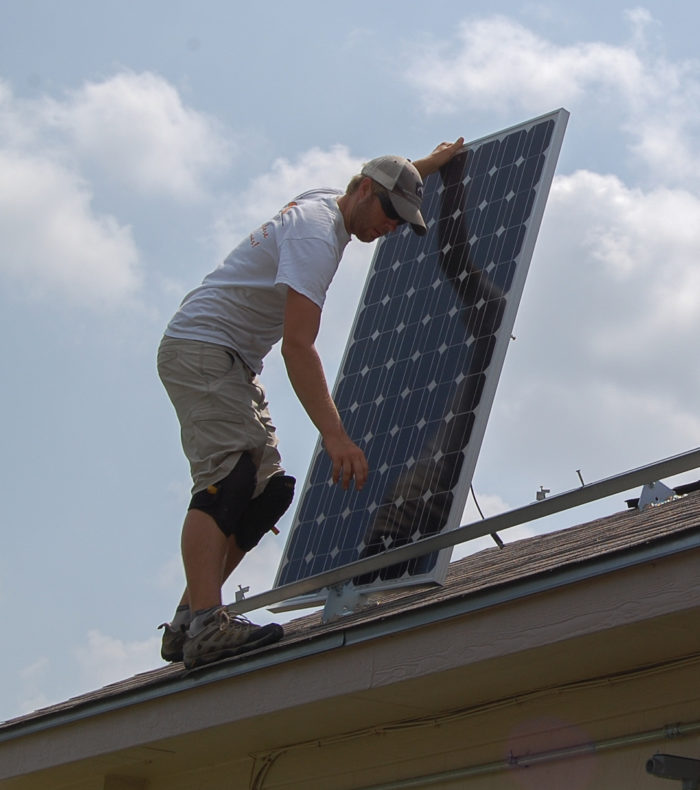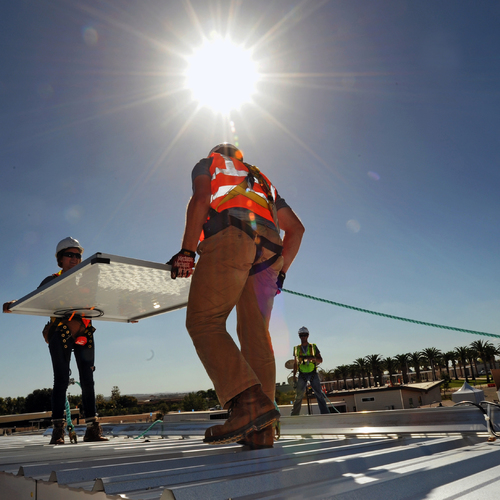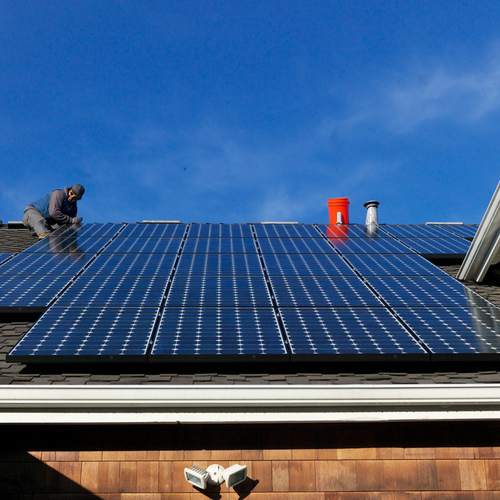
Image Credit: Austin Community College / CC BY 2.0 / Flickr
Beginning in mid-September, South Miami, Florida, becomes the first city in the state and the first outside California to require solar panels in new residential construction.
The new rules, passed by the City Commission on a 4-1 vote over the objections of local building associations, affects new houses larger than 1,100 square feet. For every 1,000 square feet of sunlit roof area, 175 square feet of solar panels must be installed, The Miami Herald reported. Houses that are built under existing trees will be exempted.
Renovated houses where more than 75% of the structure is replaced, or houses enlarged by more than 75%, also will be covered. The law does not apply to commercial properties, but it will cover townhouses and multi-story residential buildings.
South Miami joins several California cities in requiring solar panels on new construction, including Lancaster, Sebastapol, Santa Monica, and San Francisco, according to a post at Greentech Media.
But the impact of the new rule in South Miami, a city of some 12,000 people, will apparently be limited. According to the Herald, the 2.3-square-mile city is mostly residential and mostly built out, with fewer than a dozen permits issued annually for new construction.
Building associations object
South Miami Mayor Philip Stoddard, a biology professor at Florida International University, has been pressing for passage of the ordinance for years. “It’s not going to save the world by itself,” he said following the July 18 vote, “but it’s going to get people thinking about [solar].”
Others were not as enthused. One city resident, who said he’s a “really big fan” of technology, urged the City Commission to delay passage of the measure and warned residents affected by the rule would not see the return on investment that proponents had promised.
Critics also included Truly Burton, executive vice president of the Builders Association of South Florida, and Eric Montes de Oca, president-elect of the Miami Chapter of the Latin Builders Association. Both argued a better approach would be to encourage city residents to add solar rather than require them to.
“If anyone who does not want to have solar panels, then they are not welcome to live in South Miami,” Montes de Oca said in a letter to the newspaper prior to the vote. “This, I would argue, runs counter to our individual freedoms. It has the potential to increase considerably the cost to construct a new home and negatively affect new home construction within South Miami.”
The National Association of Home Builders said in a statement at its website the mandate “is casting a long shadow for builders in the Sunshine State.”
Josh Liebman, the sole commissioner to vote against the proposal, told The Real Deal the measure would slow the development of affordable housing and low-income neighborhoods. “This is government bureaucracy on the most micro-level,” he said. “We must protect freedom of choice.”
Weekly Newsletter
Get building science and energy efficiency advice, plus special offers, in your inbox.















8 Comments
Freedom to pollute and deny reality
Thats what this nonsense is about. Though i would have also required commercial buildings to install solar, the big gains come from more roof space.
Distributed solar is not a cross subsidy (@ John Clark)
Rooftop solar on new houses reduces the need for upgrading the capacity of the distribution grid, upgrades that would otherwise be paid for by increased rates for all. The value of solar is a complicated subject, but even ignoring carbon and other pollution reduction benefits, at Florida's current penetration of rooftop PV new rooftop solar delivers far more benefit to the other ratepayers than the residential-retail rates it is offsetting for the PV owner.
This is in contrast to a VERY real cross-subsidy: All ratepayers are paying for the increased distribution & transmission grid capacity required for homes with large central air conditioning & pool pumps, and the increased peak energy prices driven by that consumption.
See below for "PV generation
See below for "PV generation by residential systems is, on average, about 70%
more costly than from utility-scale PV plants. " and "costs for a typical commercial-scale installation falling somewhere in between ".
This is an inefficient tax on new home construction to fund a public awareness project. With the side effect of discouraging the planting of trees to shade homes.
http://energy.mit.edu/wp-content/uploads/2015/05/MITEI-The-Future-of-Solar-Energy.pdf
That's energy-cost only. @ Jon R
Reading the complete context of that paragraph it refers only at the LCOE of the wholesale energy costs, with the assumption that neither distributed nor utility scale solar increases distribution grid costs. It does NOT factor in the benefit of lowering the cost of the distribution grid.
Distributed solar costs more than utility scale solar on a raw energy basis, but it's also WORTH more, since it frees up existing distribution grid capacity, lowering grid maintenance costs, and putting off the need for distribution grid infrastructure upgrades. Utility scale solar does not provide those benefits, and those benefits on average are substantial, though the actual value is also locational, much higher value in some locations on the grid (those portions operating at peak loads near or above the maximum designed capacity) than others (sections where the distribution grid has a large capacity margin above the actual loads.) The true value of distributed PV to the grid in South Miami isn't well documented in the popular press, and may be unknown.
The other points regarding it as an inefficient tax on new construction etc. are well taken.
S. Miami must not have many poor people.
I only say that because in these instances the poor who do not have solar panels, because they now cannot afford to own a home that has them, end up continuing to live as tenants subsidizing those who to have solar and also sell that power back to the utility.
The commissioners of S. Miami should have read "That Which is Seen, and that Which is Not Seen" by Frederic Bastiat.
@Dana. Don't forget debt servicing
Utilities have fixed costs associated with debt servicing. Those who don't have solar are going to make up the difference in higher rates unless the Utilities are allowed to pass them onto everyone who's tied to the grid in the form of some basic charge. It'll required de-bundling of the rate.
Btw..Utilities are still going to have to continue investing in upgrades to infrastructure because they're going to have to manage the additional power flowing back towards the grid.
.
Already accounted for in value of solar studies. @ John Clark
The utilities' debt service and other financial aspects are fully included in every value of solar study.
At Florida's PV penetration rate it will be a LONG time before there are mid-day backflow issues to contend with, unlike a small number of heavily saturated neighborhoods on Oahu. In Florida's case it may literally never reach that point if people are charging their cars during high PV hours. That issue can be largely solved or made worse by the utility regulators. Solving it with infrastructure upgrades is good for the utility bottom line if they are allowed to rate-base it the cost of the upgrades, but it's not the only way to deal with it.
Jon R: Residential solar isn't entirely uncontrolled, but changes in the regulations to compensate distributed PV more in locations where it's value is higher than in other locations where it's value is less is being worked out in the New York REV, and may eventually be coming to a utility near you. Highly built out areas such as South Miami are more likely to be running near capacity limits than in newly developed areas, and it wouldn't surprise me if the value is pretty high there.
A typical short-form value of solar analysis looks like this:
http://acadiacenter.org/wp-content/uploads/2015/04/AcadiaCenter_GridVOS_Massachusetts_FINAL_2015_0414.pdf
The size of the line-items will vary by location and over time, but the line headings are pretty much the same. Transmission & distribution costs pretty much evaporate with distributed solar, but only partially (if at all) with utility scale.
Re: distributed solar saving on transmission and distribution co
New utility and commercial scale solar (say 1-10 MW) can be deliberately located closer to demand (and to near capacity grid areas) than a hundreds of MW power station, providing some of the possible savings. Exactly where residential solar will be put in is largely uncontrolled (policies are typically the same across wide areas).
In this case ("mostly built out" therefor decreasing energy intensity), I expect that the value of avoiding grid upgrades is zero. But yes, it's locational, highly variable, and needs to be calculated on a case-by-case basis. Nobody should assume that this sometimes savings makes residential net metering a generally good idea.
Log in or create an account to post a comment.
Sign up Log in